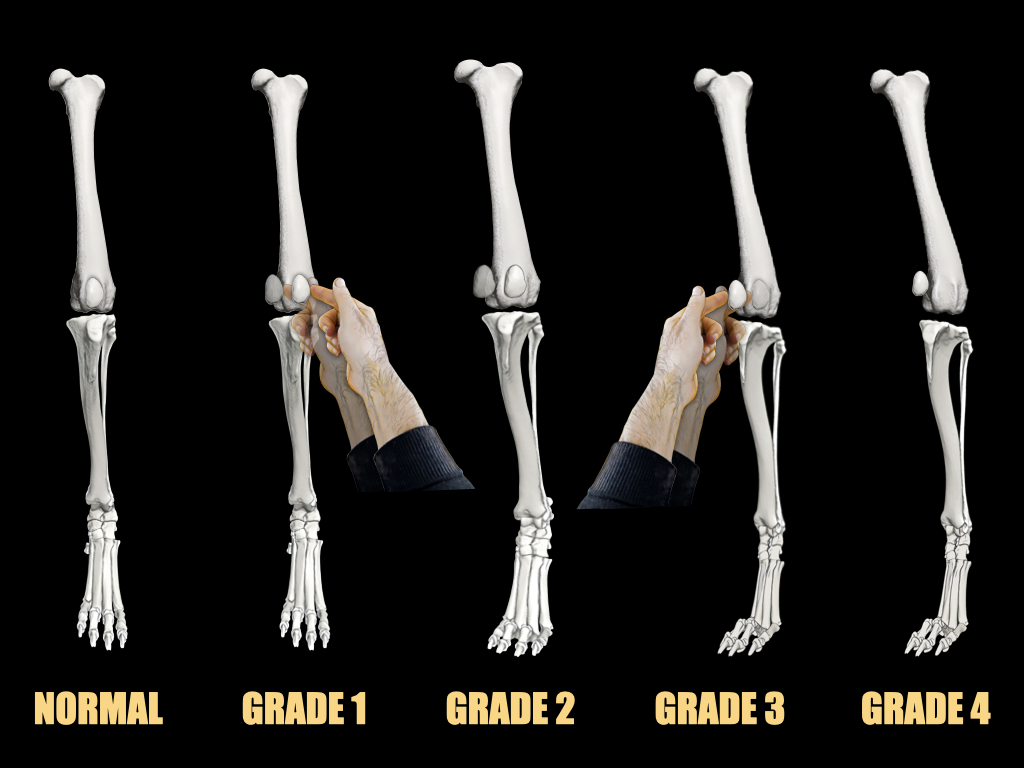Patella Luxation
Patella luxation is a relatively common orthopedic problem in dogs (and some cats as well). When a stifle (knee) bends, the patella (kneecap) should slide up and down inside a groove (patellar groove) in the front of the femur. In a normal stifle, the patella should never slip out of the patellar groove. If the patella is slipping out, this is called a luxation or dislocation. When the patella luxates, it creates a painful condition that actually stops the stifle from bending properly. Over time, the resulting rubbing of bone-on-bone can lead to arthritis. Further, the patella plays a large role in the stability of the stifle and patella luxation greatly increases the chance of cranial cruciate injury.
Patella luxation can affect either stifle and can slip either to the inside or to the outside of the patella groove. The degree of the luxation is graded in severity to help determine best course of treatment. Typically, a grading system of 1-4 is used.
 Grade I: The patella is loose but stays within the patellar groove when the stifle moves. It can be dislocated with pressure applied during a physical examination but it will immediately return to normal when released. Generally a grade 1 patella luxation does not lead to problems but should be monitored closely during regular physical examinations.
Grade I: The patella is loose but stays within the patellar groove when the stifle moves. It can be dislocated with pressure applied during a physical examination but it will immediately return to normal when released. Generally a grade 1 patella luxation does not lead to problems but should be monitored closely during regular physical examinations.
Grade II: The patella dislocates sometimes when the stifle bends but usually returns to the groove on its own. Symptoms vary from mild to moderate depending on how often the patella luxates.
Grade III: The patella is permanently dislocated. It can be pushed back into place but immediately slips out of the groove or as soon as the stifle bends. Dogs with grade 3 luxations are frequently lame.
Grade IV: The patella is permanently dislocated and cannot be pushed back into place. Affected dogs do not have a normal gait.
What causes patella luxation?
Most cases happen because of an abnormal shape to the bones at the knee. Small-breed dogs are the most commonly affected but this problem can be seen in any breed of dog (and cats too). As the dog grows, there is often a twist to the end of the femur, and over time, the problem generally worsens.
There are also a group of animals that suffer a traumatic injury which causes the luxation.
What are the symptoms of patella luxation?
The most common symptom seen will be intermittent skipping or hopping on the affected back leg. Many dogs act perfectly normal and then suddenly have their knee "go out" in which case it is difficult for them to straighten the leg and they will often hold it up. Other dogs may walk normally but tend to hold the leg in the air when they run.
The range of motion of dogs with patella luxation is often limited and can be seen as a general stiffness of the back legs.
How quickly should I act if I think that my dog has a patella luxation?
The longer that a problem is present, the more potential for long-term problems like arthritis or cranial cruciate injury exists. If a dog is limping for more than a day following an injury or if limping comes and goes, a veterinarian skilled in orthopedics should be contacted.
Patella Luxation Treatment
Treatment recommendations will depend on the grade of the luxation. A grade I and mild grade II cases may be managed medically and with physical therapy.
Surgery is necessary for many dogs suffering from grade II patella luxation and nearly all dogs suffering from grade III or grade IV. There are a number of different surgical procedures used in the treatment of this disease, and the specific treatment must be adapted to the individual dog. In most cases, the patella groove is deepened while protecting its cartilage surface. Very often the tibial crest (shinbone) must be moved into better alignment. Finally, the connective tissue about the patella is stabilized. In severe cases, especially grade IV, correction of angular limb deformity may be required.
Pain relief is important through the treatment of patella luxation. Many people do not realize that their dog is in pain, but it is safe to assume that if a leg is being held up or limped on, it hurts!
At The Hometown Veterinarian, we have extensive experience treating patella luxation. If patella luxation surgery is needed, we have the equipment, skills, and knowledge to give your pet the best chance of success.
Call our office at 641-758-3333 to set up an evaluation or click to Request an Appointment.
